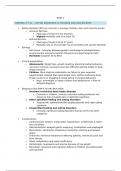Week 1
CAMPBELL ET AL. – EATING DISORDERS IN CHILDREN AND ADOLESCENTS
Eating disorders (ED) are common in younger children, boys and minority groups
o Anorexia Nervosa
Peak age of onset of 13 to 18 years
Highest mortality rate of at least 5%
o Bulimia Nervosa
Peak age of onset of 16 to 17 years
Mortality rate of 2% but high risk of suicidality and suicide attempts
Etiology
o Not known - Interplay between genetic and biological predispositions,
environmental and socio-cultural influences and psychological traits
o Heritable (between 30 to 85%)
Clinical presentation
o Adolescents: Weight loss, growth stunting, abnormal eating behaviors,
recurrent vomiting, excessive exercise, difficulty gaining weight or body
image concerns
o Children: More atypical presentation as failure to gain expected
weight/height (instead that rapid weight loss), without endorsing body
image concerns or engaging in binge eating or purging behaviors
Boys, overweight or obese children and adolescents → Risk for
delayed diagnosis
Diagnosis (See DSM-5 for AN, BN & BED)
o Avoidant restrictive food intake disorder
Common in children, involves restrictive eating behaviors not
driven by fear of weight gain or distorted cognitions
o Other specified feeding and eating disorders
Atypical AN, subthreshold BN, purging disorder and night eating
syndrome
o Unspecified feeding and eating disorders
Clinically significant eating disorders that do not fit into other
categories
Complications
o Cardiovascular system: bradycardia, hypotension, arrhythmias & heart
rate variability
o Gastrointestinal: delayed gastric emptying, constipation and esophagitis
o Electrolytes: electrolytes imbalances caused by vomiting and laxative
abuse
o Endocrine: hormonal imbalances affecting puberty, menstrual cycle and
bone density
o Renal: dehydration and renal insufficiency
o Hematologic: leukopenia and anemia because of low-weight
o Neurologic: structural and cognitive deficits in children and adolescents
(permanent?)
, o Psychiatric: comorbid disorders as depression, anxiety, substance abuse,
OCD and self-injurious behaviors
Treatment modalities
It is recommended a low threshold for adolescents with ED due to the potential
irreversible effects on growth, mortality risk and evidence supporting improved
outcomes in early treatment
o Adolescents are treated through outpatient, partial hospitalization,
residential or inpatient programs based on severity, duration, safety and
familial preferences
Family-based treatment (FBT)
o Focuses on nutritional rehabilitation as the primary initial treatment (6 to
12 months)
o Three phases targeting recovery:
(1) Physical: Coaching parents to refeed their child → Food
exposure
(2) Behavioral: Developmentally appropriate control of eating
back to the child/adolescent
(3) Psychological: Relapse prevention
o Effectiveness in adolescents & young adult with AN → Strong evidence of
full remission
CBT shows promise especially in BN
Pharmacotherapy
o Limited evidence
o Antidepressants have shown efficacy in BN, while SSRIs seem effective in
BED
Recovery
Behavioral: Normalizing eating patterns and regaining flexibility in eating habits
Psychological: Improved self-esteem and age-appropriate functioning in
interpersonal, psychosocial and occupational aspects
Physical: Full weight restoration, menstrual cycles and/or pubertal progression,
reversal of organ damage and attainment of normal growth and pubertal patterns
Nutritional: Reaching a goal weight and the ability to maintain a varied and
balanced diet
LIMBERS ET AL. – EATING DISORDERS IN ADOLESCENT AND YOUNG ADULT MALES
Males: largely underrepresented in the ED literature because of the stigma that
causes them to minimize or deny the presence of symptoms but they are also at
high-risk
o Risk factor: Sexuality → Gay or bisexual exhibits higher rates of ED
Differences with females:
o Less shape and weight concerns
o Less body dissatisfaction
o Less drive for thinness → Concerns of being “bigger” and more muscolar
(AN excluded)
Muscle dysmorphic disorder (dysmorphic disorder proposed as type
of ED)
, Enhance muscolarity including dieting, weifhtlifting and
steroids
o Less likely to eat in response to negative emotions, sense of loss of control
when binge eating and restricting their food because of body
dissatisfaction
o Less likely to engage in dieting, laxative use and self-induced vomiting in
bulimic cases
Assessment
o Eating Disorder Examination (EDE) assess frequency and intensity of
behavioral and cognitive symptoms associated with ED and its frequently
used
It was created and normed for female populations → Caution is
necessary when applying it to diagnose adolescent and
young adult males
o Eatin Disorder Assessment for Men (EDAM) created but more research
needed
Treatment
o Adolescents: Family-based treatment is the only well-established
o Young adults: CBT and intepersonal psychotherapy are well-established
and there is preliminary evidence for family-based treatment
Males less likely to seek treatment (-minority groups - low SES)
o Misconception that ED affects females
o Shame and stigma
o Physician less likely to recognize symptoms due to lower rates of incidence
and differences in symptoms presentation
Critical factors: Improving interpersonal interaction, therapist
characteristics and quality of the therapeutic relationship
Attention should be given to a heightened prevalence of comorbid
substance abuse disorders and the role that competitive sports play
WILSON – COGNITIVE-BEHAVIORAL THERAPY FOR EATING DISORDERS
Bulimia nervosa (BN): Abnormal overevaluation of the importance of body
shape/weight → Dysfunctional dieting and other extreme, unhealthy weight-control
behaviors (purging) → Binge-eating
CBT: Replace dysfunctional dieting with a regular and healthy pattern of eating,
ceasing purging and other extreme forms of weight control and decreasing
overevaluation of body shape/weight
o Risk factor and maintaining mechanisms: dysfunctional dieting
Reducing the strict control helps overcoming the disorder
CBT-E (enhanced-behavioral therapy): Revised version which is personalized to
the patient
o CBT-Ef (focused): Address overevaluation of body weight/shape and treats
the “mood intolerance” → Trigger of binge eating and purging
o CBT-Eb (broad): Address comorbid disorders that maintain/complicate
eating disorder → Perfectionism, low self-esteem and interpersonal
difficulties
CBTgsh (guided self-help)
, o Guided self-help based on the principles and procedures of CBT
o Effective first-level treatment: rapid reduction in binge eating, greater
acceptability and lower cost than family therapy
Treatment efficacy
o CBT is more effective than either antidepressants or other psychological
treatments as interpersonal psychotherapy (IPT)
o Predictors of improved outcome: Early response to CBT
o Predictors of poorer outcome:
No responders in the early course of therapy
Longer history of eating disorder
Overevaluation of the importance of body shape/weight
Binge-eating disorder (BED):
CBT: Reduce frequency of binge eating at follow up and high rates of remission
o CBT is more effective than either antidepressants or behavioral weight
loss (BWL)
Combining medication with CBT produced superior outcomes to
pharmacotherapy only but does not enhance the outcome yielded
by CBT only
CBTgsh
o Effective as IPT in maintain improvements at follow-up and both superior
to BWL
o More effective than treatment-as-usual (TAU) in remission rates
Treatment efficacy
o Predictors of improved outcome: Early response to CBT
CBT + IPT can be used when there is a failure in finding rapid
response since IPT its efficacious with both rapid and nonrapid
responders
o Predictors of poorer outcome:
Overevaluation of the importance of body shape/weight
Anorexia nervosa (AN):
CBT-E
o Support for the treatment of anorexia nervosa
Improvement in eating disorder psychopathology and increased
weight
As effective as TAU → Probably related to the study’s design
Effectiveness and scalability of CBT
Evidence-based treatment for all eating diagnoses for both adolescents and
adults
More effective in the long-term compared to IPT and pharmacological treatment
No significant differences among different ethnic and racial groups in treatment
outcome
Cost-effective
o Brief CBTgsh is as effective as lengthier manual-based CBT for BN and
BED
o Guided-self-help is more effective than pure self-help without support from
a counselor






